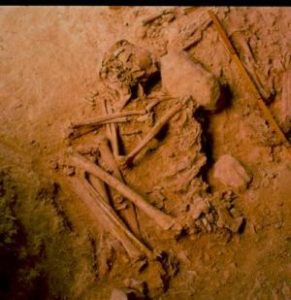
PLOS—The genomes of individuals who lived on the Iberian Peninsula in the Bronze Age had minor genetic input from Steppe invaders, suggesting that these migrations played a smaller role in the genetic makeup and culture of Iberian people, compared to other parts of Europe. Daniel Bradley and Rui Martiniano of Trinity College Dublin, in Ireland, and Ana Maria Silva of University of Coimbra, Portugal, report these findings July 27, 2017 in PLOS Genetics.*
Between the Middle Neolithic (4200-3500 BC) and the Middle Bronze Age (1740-1430 BC), Central and Northern Europe received a massive influx of people from the Steppe regions of Eastern Europe and Asia. Archaeological digs in Iberia have uncovered changes in culture and funeral rituals during this time, but no one had looked at the genetic impact of these migrations in this part of Europe. Researchers sequenced the genomes of 14 individuals who lived in Portugal during the Neolithic and Bronze Ages and compared them to other ancient and modern genomes. In contrast with other parts of Europe, they detected only subtle genetic changes between the Portuguese Neolithic and Bronze Age samples resulting from small-scale migration. However, these changes are more pronounced on the paternal lineage. “It was surprising to observe such a striking Y chromosome discontinuity between the Neolithic and the Bronze Age, such as would be consistent with a predominantly male-mediated genetic influx” says first author Rui Martiniano. Researchers also estimated height from the samples, based on relevant DNA sequences, and found that genetic input from Neolithic migrants decreased the height of Europeans, which subsequently increased steadily through later generations.
The study finds that migration into the Iberian Peninsula occurred on a much smaller scale compared to the Steppe invasions in Northern, Central and Northwestern Europe, which likely has implications for the spread of language, culture and technology. These findings may provide an explanation for why Iberia harbors a pre-Indo-European language, called Euskera, spoken in the Basque region along the border of Spain and France. It has been suggested that Indo-European spread with migrations through Europe from the Steppe heartland; a model that fits these results.
Daniel Bradley says “Unlike further north, a mix of earlier tongues and Indo-European languages persist until the dawn of Iberian history, a pattern that resonates with the real but limited influx of migrants around the Bronze Age.”
_______________________________________
Archaeological remains of individual MC337 excavated from the site of Hipogeu de Monte Canelas I, Portugal, and analysed by the archaeologist Rui Parreira and the anthropologist Ana Maria Silva. Credit: Rui Parreira
_______________________________________
Article Source: PLOS ONE news release
_______________________________________
*Martiniano R, Cassidy LM, Ó’Maoldúin R, McLaughlin R, Silva NM, Manco L, et al. (2017) The population genomics of archaeological transition in west Iberia: Investigation of ancient substructure using imputation and haplotype-based methods. PLoS Genet 13(7): e1006852. https://doi.org/10.1371/journal.pgen.1006852
____________________________________________________
Receive 30 days free access to the popular new CuriosityStream lineup of documentaries on science, history, nature, and technology as a new Popular Archaeology premium subscriber.
___________________________________________
Travel and learn with Far Horizons.
____________________________________________
This richly illustrated issue includes the following stories: Recent findings shedding new light on the whereabouts of the remains of Philip of Macedon, father of Alexander the Great; how an archaeologist-sculptor is bringing bones of the dead back to life; archaeologists uncovering town life at the dawn of civilization; an exclusive interview with internationally acclaimed archaeologist James M. Adovasio about what makes the Meadowcroft Rockshelter prominent in the ongoing search for the first Americans; what archaeologists are finding at the site of the ancient city of Gath, the home town of the biblical Philistine giant, Goliath; and how scientists are redrawing the picture of human evolution in Europe. Find it on Amazon.com.






